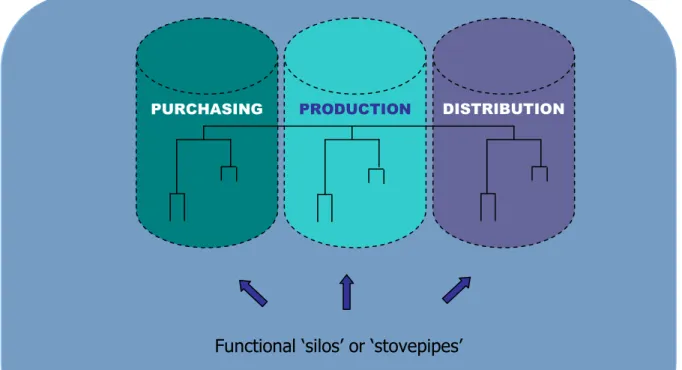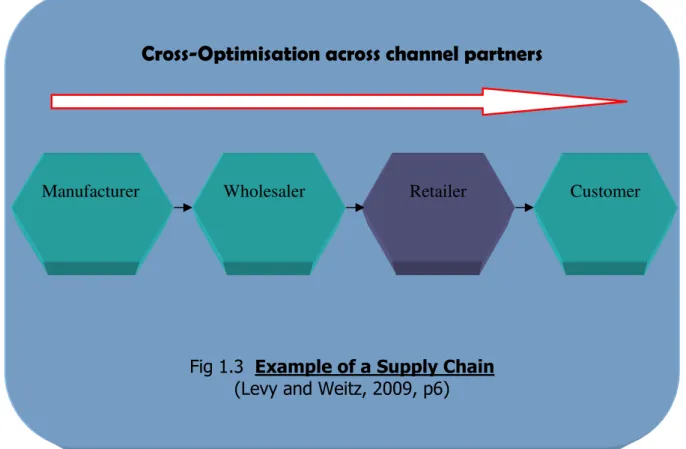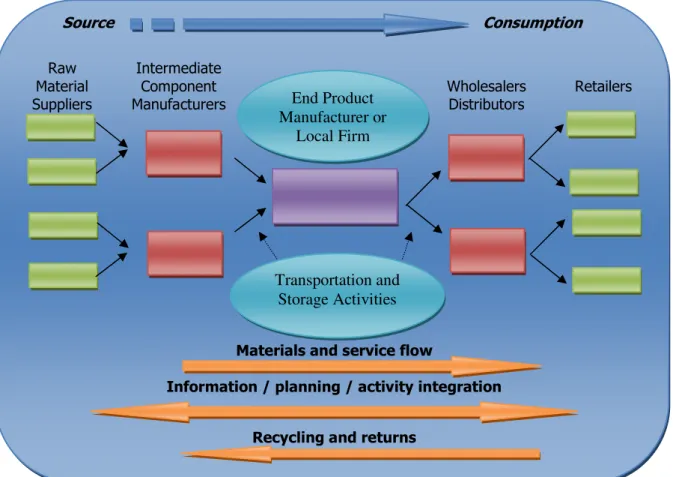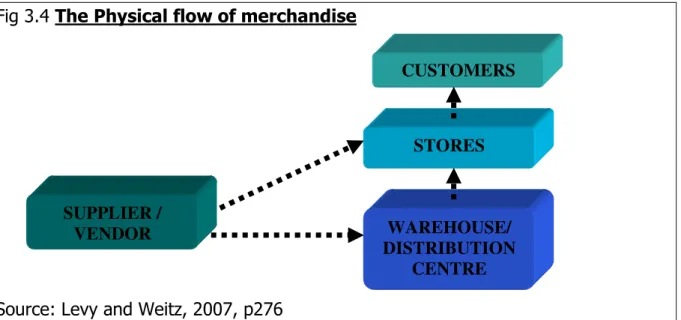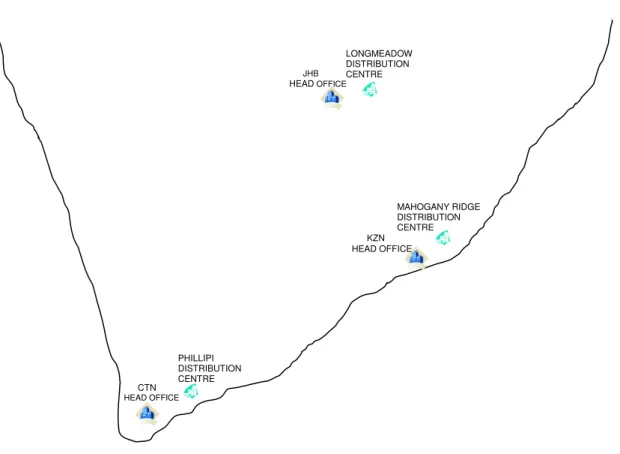The purpose of this research is to explore the relationship between supply chain management and business information system technology within the food and drug retail sector with particular reference to optimal efficiency. The relationship between supply chain management and business information system technology is multifaceted and complex in nature, and therefore, has the ability to permeate every element of an organization's functionality.
INTRODUCTION
Introduction to the Study
The relationship between supply chain management and business information systems technology has also provided a platform to facilitate strategic relationships between organizations and markets, regardless of their global position. Recently, large companies in the food and drug retail sector have taken the use of supply chain management and business information system technology to new heights.
Statement of the research problem
Objectives of the research study
Background and purpose of the study
The term 'analysis' is described as "The breaking down of an intellectual or material whole into its component parts for individual study" (Farlex Free Dictionary, online, analysis defined, paragraph 1). Therefore the meaning of the term 'critical analysis' can best be described as a careful and accurate assessment resulting in a reasonable interpretation and judgment of a material whole (for example: SCM) by dividing it into component parts (procurement, inbound and outbound logistics, operations, etc.) to study each part separately.
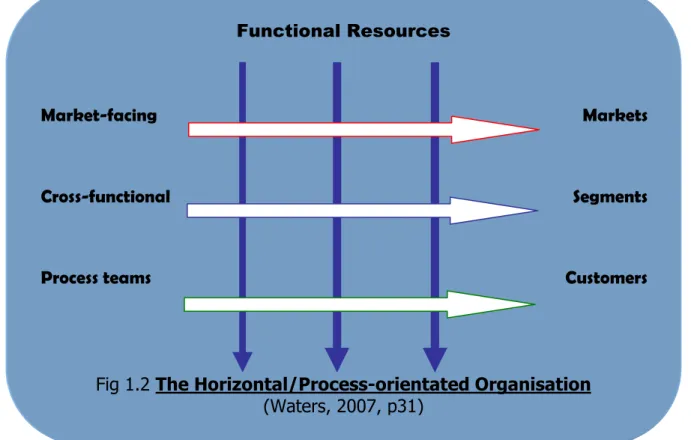
Motivation for the study
The three major food and drug retail chains in South Africa are Pick 'n Pay stores, Shoprite Holdings and Spar Group. The need to optimize supply chain efficiency through the use of BIS technology in the food and pharmaceutical retail sector was emphasized.
Brief discussion on business information system technology in the business
Therefore, the efficient and effective use of BIS technology that facilitates information, product, service and financial flows through a chain of suppliers can improve market responsiveness by speeding the right products and services to market; increase revenue and profitability, reduce operating costs and thus provide a competitive advantage.
Brief description of supply chain management in the business environment
According to Hugo et al, "The globalization of markets is perhaps the most important driving force in the creation of supply chain management" (Hugo et al, 2004, p258). Supply chain management is becoming central to the survival of enterprises in a global business environment” (Hugo et al, 2004, p5).
Theoretical basis of the research study
If a firm can supply the market at a lower cost than the market itself, competition will cause it to prevail. The 'Theory of the Firm' set out to describe the nature of the firm, its behavior and its relationship to the market" (Theory of the Firm, online, para 1).
Brief history on the global food and drug retail sector
Food and drug retailers seek a low-cost competitive advantage when selling standardized products (Interview with Leanne Mounter). In addition, the food and drug retail sector stocks both perishable and non-perishable goods for its customers.
Scope of the study
To assess the parameters of the empirical research contribution, a detailed illustration of Pick 'n Pay's supply chain/network structures and information flows will be examined. Empirical research information will be obtained from the Pick 'n Pay Group Ltd chain of stores, through in-depth interviews, in order to conduct a thorough investigation into the relevant relationship that SCM has with BIS technology within Pick 'n retailing. Pay. food and drug chain in KwaZulu-Natal.
Brief Introduction to Pick ‘n Pay’s food and drug retail chain in South Africa
They are smaller, yet better equipped to provide the best services to customers whose priority is convenience shopping (The Pick 'n Pay Family, online, Anon, para 4). According to Leanne Mounter, Pick 'n Pay uses an advanced, integrated BIS known as SAP R/3 (interview with Leanne Mounter).
An overview of related studies
Their focus is primarily on the low-cost, low-margin operations and retailing of merchandise in South Africa's rural market (The Pick 'n Pay Family, online, Anon, para. 7). Pick 'n Pay's values, such as: fighting for customer rights, respecting each other, promoting personal growth and opportunity, nurturing leadership skills, rewarding innovation and shared responsibility, harvest a combination of effective SCM techniques simultaneously with the use of BIS technology.
Summary and application of related overviews
- An interpretive study of software risk management perspectives
- Intellectual capital management in a South African retail company
Today, intellectual capital is seen as a competitive advantage, as organizations that receive accurate information in a timely manner will be able to respond to changing market conditions faster than technology-enabled competitors. When intellectual capital is effectively managed throughout the supply chain, it is not just individual firms that respond to direct changes, but the supply chain as a whole (Hamzah and Ismail, 2008, p. 5).
Delimitations of the study
Furthermore, supply chain networks are intrinsically dependent on BIS technology to facilitate information flows from source to consumption and enable more accurate decision making. To ensure responses came from the recipients, interviews were conducted with each recipient and they were encouraged to answer as many questions as possible.
Methodology
This information will then be applied to a case study approach to Pick 'n Pay (Pty) Ltd corporate stores in KwaZulu-Natal. The term case study refers to the fact that a limited number of units of analysis are studied intensively.
Summary
For the purposes of this investigation, a case study approach has been adopted as the main research methodology, due to its ability to facilitate an in-depth exploratory study of the phenomena in question in context-rich and dynamic settings. The focus of this research is primarily on the food and drug retail sector in KwaZulu-Natal, South Africa.
Framework for the Study
The collected data will be examined to provide a statistical analysis of the data received in relation to the secondary data found in the literature review. A comprehensive summary of the research and its findings will be provided along with any limitations to the empirical research element.
REVIEW OF RELATED LITERATURE IN THE FIELD OF
Introduction
- Business defined
- Information defined
- Systems defined
- Information technology defined
Information technology is hardware, software and communications that support information systems” (Benson and Standing, 2005, p. 9). The hardware component of information technology consists of the mechanical devices that perform the input, processing, data storage and output functions.
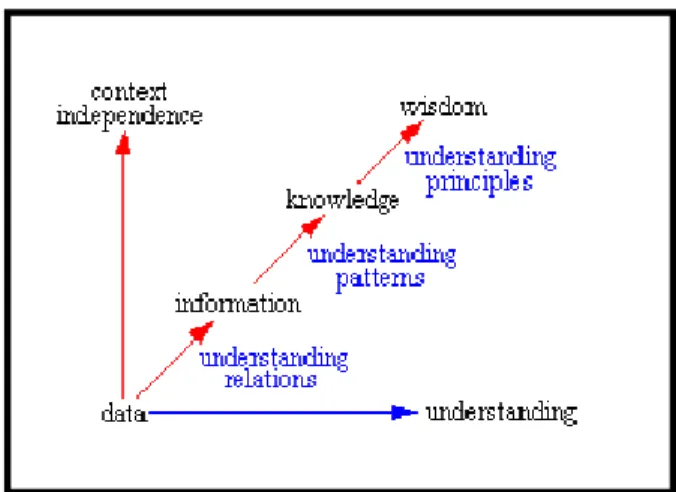
Background to business information system technology
The Internet is operated and maintained by a collection of non-governmental organizations” (Yeates et al, 2004, p.412). Because of the inter-organizational information systems nature of the Internet, it has been adopted as a routine platform for information systems development (Williamson, Harrison, & Jordan, 2004, Section 1).
What business information systems have to offer the business environment
- Business information system architectures
- Core-competencies in business information systems
- Time Compression
- Data sourcing and manipulation
- Facilitated information flows
This alignment is necessary to ensure that the right information is sourced in order to move the organization forward. They are designed to optimize and synchronize business processes across a supply chain in order to meet multi-level requirements.
Business information system technology in the retail sector both globally and
- SAP/R3 in business
- Oracle in business
Oracle customers are asked to complete surveys to guide Oracle's planning and decision-making process to ensure improvements across the enterprise. In addition, Oracle has established customer forums to open communication between Oracle's executive management, product development teams and their customers.
Challenges faced by the South African retail sector and business information
What are some of the key challenges Pick 'n Pay faces with supply chain management. What would you say Pick 'n Pay's strengths are in their supply chain management.
The latest trends in business information system technology in this arena
Summary
BIS has a number of key competencies such as compression time, data acquisition and processing, and initiating information flows within the organization and its partners. BIS are used on a global and local scale in the retail sector, and competitive advantages are constantly changing with the changing landscapes in SCM and BIS.
REVIEW OF RELATED LITERATURE IN THE FIELD OF SUPPLY
Introduction
Historical overview of supply chain management
The bullwhip effect creates a distortion of replenishment orders, which spreads the enhanced supply chain up” (Bolarin and McDonnell, 2008, p. 9). In the early 1980s, according to Waters, Olivier developed the term 'supply chain management' "to describe the amalgamation and relabelling of established functions - notably 'logistics' (integrated transport, warehousing and distribution) and 'operations management' , based on production (elements of procurement, order and inventory management, production planning and control, and customer service)” (Waters, 2007, p. 227).
Supply chain defined
In summary, Wisner et al state, “The series of companies that ultimately make products and services available to consumers, including all the functions that enable the production, delivery, and recycling of materials, components, end products, and services, is called a supply chain.” ( Wisner et al, 2005, p6).Waters concludes that "The supply chain is a meta-organization, a system of connections that transcends organizational boundaries and recognizes interdependence between individual enterprises" (Waters, 2007, p162).
Management defined
Thus, supply chains and their management play a fundamental role in determining a company's long-term success or failure. This brings to the fore SCM and its importance as a core competency for any organization.
Supply chain management described
Channel members within the supply chain use their support value activities (infrastructure, human resources, technologies and purchasing) to drive the primary activities (receipt and storage of raw materials, transformation of materials, marketing and delivery of services and end products). . Supply chain partner relationships are based on sharing trust, resources, costs and profits.
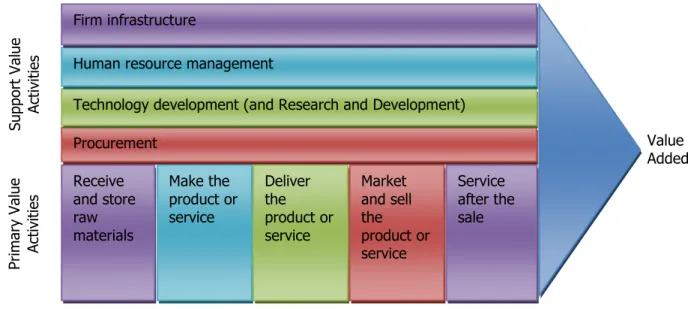
What supply chain management has to offer the business environment
- Supplier selection and collaborative planning
- Decision making
- Demand forecasting
- Cost reduction
- Time compression/Process integration
- Customer relationship Management
- Service response logistics
The focus is on strengthening the supply chain structure in order to meet time-based targets. Customer service is perhaps the most important interface between the market and the supply chain.
Supply chain management in the food and drug retail sector
The physical distribution of merchandise in the global food and drug retail
The physical distribution of merchandise in the food and drug retail sector
Distribution centres vs direct distribution
Collaboration between retailers and vendors
Challenges faced by the food and drug retail sector in the field of supply
The latest trends in supply chain management
Summary
Introduction
In Chapter 3, the importance of SCM in business within the food and drug retail sector was discussed. It is important to note that SCM relies on BIS technology to function.
The relationship between supply chain management and business
- Demand forecasting
- Decision making
- Supplier relationship management
- Operations management
- Transportation and distribution
- Customer relationship management
Their combined influence of supply chain management and business
Challenges faced by business information system technology and supply
Multi-source problems are experienced when “retailers work with multiple media and use multiple database management systems running on multiple platforms, thus facing a number of challenges” (Rao, 2000, p.113). Human resource problems are experienced when the workforce is unskilled and lacks business focus and dedication to support business information technology efforts (Rao, 2000, p.114).
Summary
RESEARCH METHODOLOGY OF THE STUDY
- Introduction
- Statement of the research problem
- Formulation of the research problem
- Research objectives
- Research design
- Research method and procedures
- Statistical Analysis
- Specifying the target population
- Number of participants
- Data collection methods
- Discussion of ethical issues
- Summary
Furthermore, "the method of collection must be free from personal bias" (Martins et al, 1999, p. 124). The rationale for interviewing managers from different management levels is to ensure that a holistic management perspective (ie, strategic, tactical and practical) is obtained on these BIS and SCM processes.
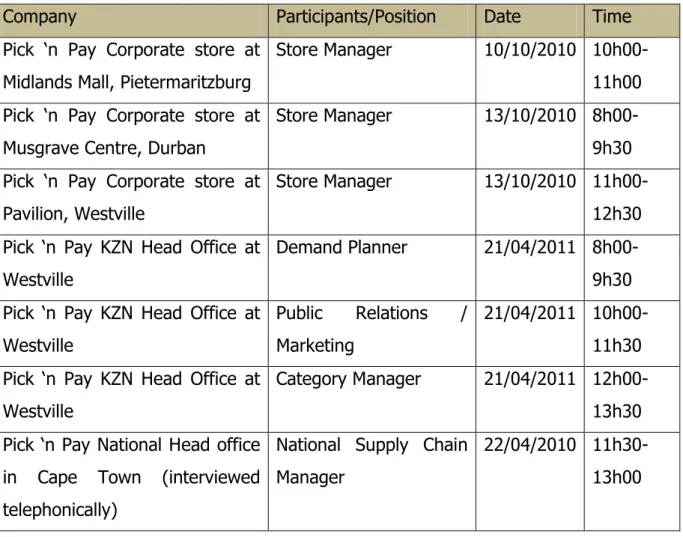
FINDINGS & RECOMENDATIONS
Introduction
Summary background to Pick ‘n Pay’s information technology department
The business information technology requirements within Pick ‘n Pay
- Criteria for business information system selection
- Business information system technologies and their influence on Supply
- Demand Forecasting
- Collaborative Planning, Forecasting and Replenishment
- Purchasing
- Transportation
- Distribution
- Operations
- Customer Relationship Management
- The importance of real-time information to Pick ‘n Pay’s performance
- The business information system trends within Pick ‘n Pay corporate stores
- The Implications of Software upgrades
The supply chain management requirements and influence within Pick ‘n
- Supplier selection and evaluation
- Quality accreditation
- Collaborative planning, forecasting and replenishment
- Inventory management
- Decision making
- Time compression
- Customer Relationship Management
- Supply chain management trends within Pick ‘n Pay corporate stores in
- Supply chain management influence within Pick ‘n Pay corporate stores in
- An illustration of Pick ‘n Pay’s supply chain within South Africa
- The Challenges and constraints between BIS enablers and SCM needs
Summary
SAP technology together with Pick 'n Pay's plug-in commercial software packages provide a comprehensive solution to their SCM requirements. Pick 'n Pay has taken significant steps towards optimizing their operations in the DCs, receiving, store operations, decision making, time compression and customer relationship management.
SUMMARY, RECOMMENDATIONS
Introduction
Pick 'n Pay has also set goals to achieve optimal efficiency of its supply chain activities. How BIS and SCM facilitate strategic relationships between suppliers and markets in the Pick 'n Pay supply chain.
The relationship between business information systems and supply chain
How Pick ‘n Pay’s business information system technology makes their supply
Challenges and constraints providing areas for further research
This affects 30% of Pick 'n Pay's product flows and hinders their ability to serve the international market. Pick 'n Pay's move to DCs has resulted in significant improvements to product availability and reliability.
Summary
Recommendations
Pick 'n Pay's supply chain exhibits adversarial, fragmented relationships with multiple suppliers, where each partner in the chain competes for the lion's share of the profits. In order for Pick 'n Pay's supply chain management to be effective so that they can take advantage of economies of scale in a way that individual organizations cannot compete with, they need to reduce their supplier base and build some relationships of loyalty and trust. .
Caveats/limitations
This will not only correlate with international standards, but build supply chain accountability and traceability that will facilitate product flow and recall processes. It will also enable the supply chain to go green by building accountability in the disposal of products throughout the supply chain.
Recommendations for further research
Conclusion
A Systematic Literature Review, The ICFAI Journal of Supply Chain Management, Vol 5, No. 1, The Icfai University Press, Yavatmal, India. Available at: http://www.information-age.com/channels/business-applications/features/272056/sap-rethinks-software.thtml. 2010) Global Journal of Enterprise Information System potential of information system in supply chain management.
Ethical Clearance
